1997 TOYOTA 4RUNNER engine
[x] Cancel search: enginePage 159 of 223
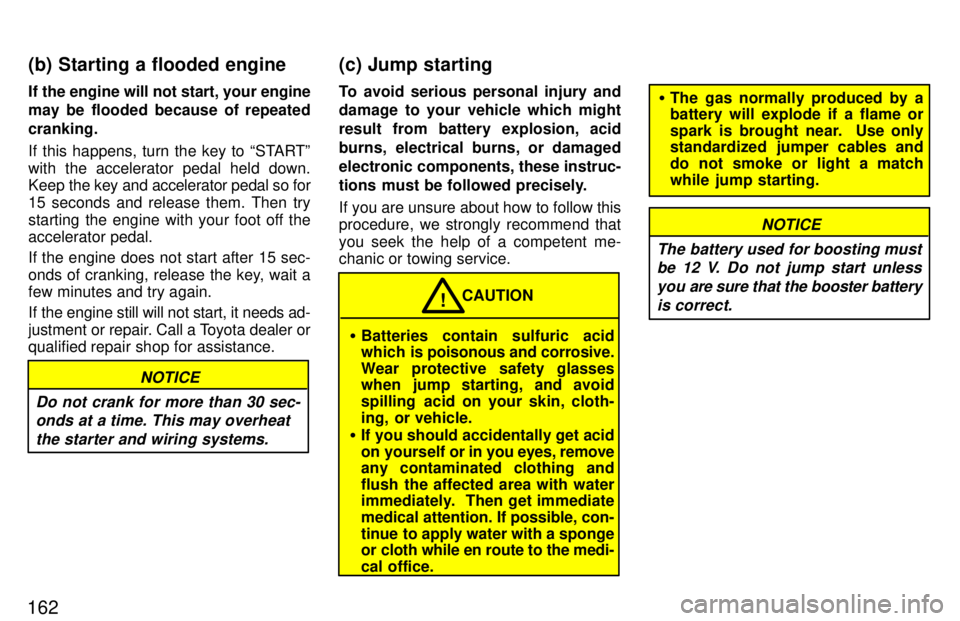
162If the engine will not start, your engine
may be flooded because of repeated cranking.
If this happens, turn the key to STARTº with the accelerator pedal held down.
Keep
the key and accelerator pedal so for
15 seconds and release them. Then try
starting the engine with your foot off the accelerator pedal.
If the engine does not start after 15 sec-
onds of cranking, release the key, wait a few minutes and try again.
If the engine still will not start, it needs ad-
justment or repair. Call a Toyota dealer or
qualified repair shop for assistance.
NOTICE
Do not crank for more than 30 sec- onds at a time. This may overheat
the starter and wiring systems.
To avoid serious personal injury and
damage to your vehicle which might
result from battery explosion, acid
burns, electrical burns, or damaged
electronic components, these instruc-
tions must be followed precisely.
If you are unsure about how to follow this procedure, we strongly recommend that you seek the help of a competent me-
chanic or towing service.
� Batteries contain sulfuric acid
which is poisonous and corrosive.
Wear protective safety glasses
when jump starting, and avoid
spilling acid on your skin, cloth-
ing, or vehicle.
� If you should accidentally get acid
on yourself or in you eyes, remove
any contaminated clothing and
flush the affected area with water
immediately. Then get immediate
medical attention. If possible, con-
tinue to apply water with a sponge
or cloth while en route to the medi- cal office. CAUTION
!
�
The gas normally produced by a battery will explode if a flame or
spark is brought near. Use only
standardized jumper cables and
do not smoke or light a match
while jump starting.
NOTICE
The battery used for boosting must be 12 V. Do not jump start unless
you are sure that the booster batteryis correct.
(b) Starting a flooded engine (c) Jump starting
Page 160 of 223

163
JUMP STARTING PROCEDURE
1. If the booster battery is installed in
another vehicle, make sure the ve-
hicles are not touching. T urn off all un-
necessary lights and accessories.
2. If required, remove all the vent plugs from the booster and discharged bat-
teries. Lay a cloth over the open vents
on the batteries. (This helps reduce
the explosion hazard, personal injuries
and burns.)
3. If the engine in the vehicle with the booster battery is not running, start it
and let it run for a few minutes. During
jump starting, run the engine at about
2000 rpm with the accelerator pedal
lightly depressed.
4. Make the cable connection in the ordera, b, c, d.
a. Connect the clamp of the positive (red) jumper cable to the positive (+)
terminal on the discharged battery.
b. Connect the clamp at the other
end of the positive (red) jumper cable
to the positive (+) terminal on the
booster battery.c. Connect the clamp of the negative
(black) cable to the negative (-) termi-
nal on the booster battery.
d. Connect the clamp at the other
end of the negative (black) jumper
cable to a solid, stationary,
un-painted, metallic point of the ve-
hicle with the discharged battery.
The recommended connecting points are
shown in the following illustration:
Page 161 of 223
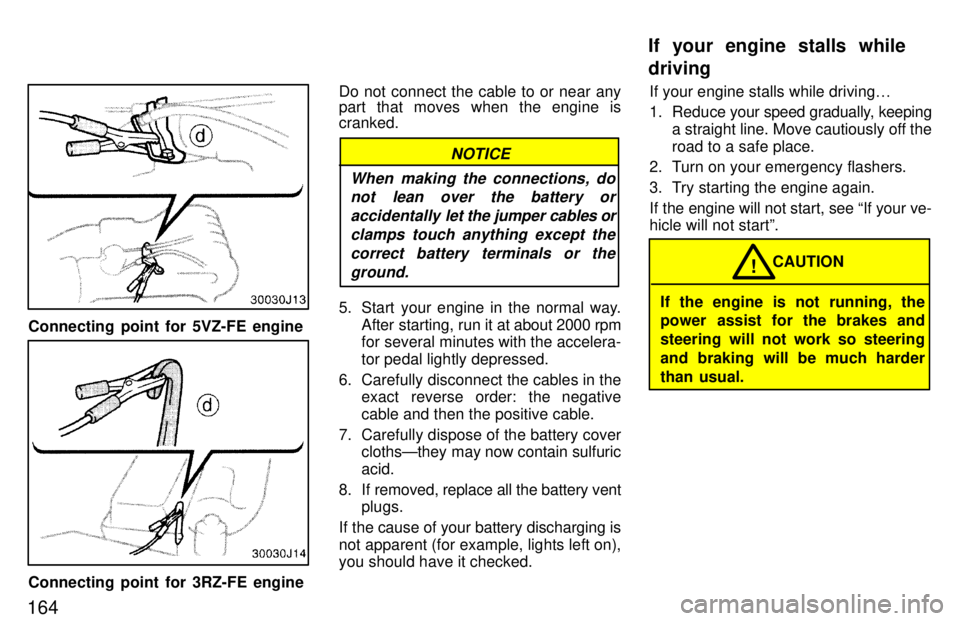
164
Connecting point for 5VZ-FE engine
Connecting point for 3RZ-FE engineDo not connect the cable to or near any
part that moves when the engine is cranked.
NOTICE
When making the connections, do not lean over the battery or
accidentally let the jumper cables or
clamps touch anything except the correct battery terminals or the ground.
5. Start your engine in the normal way. After starting, run it at about 2000 rpm
for several minutes with the accelera- tor pedal lightly depressed.
6. Carefully disconnect the cables in the exact reverse order: the negative
cable and then the positive cable.
7. Carefully dispose of the battery cover clothsÐthey may now contain sulfuricacid.
8. If removed, replace all the battery vent plugs.
If the cause of your battery discharging is
not apparent (for example, lights left on), you should have it checked. If your engine stalls while driving
0
1. Reduce your speed gradually, keeping
a straight line. Move cautiously off the
road to a safe place.
2. Turn on your emergency flashers.
3. Try starting the engine again.
If the engine will not start, see If your ve-
hicle will not startº.If the engine is not running, the
power assist for the brakes and
steering will not work so steering
and braking will be much harder
than usual. CAUTION
!
If your engine stalls while driving
Page 162 of 223

165
If your engine coolant temperature
gauge indicates overheating, if you
experience a loss of power, or if you
hear a
loud knocking or pinging noise,
the engine has probably overheated.
You should follow this procedure 0
1. Pull safely off the road, stop the ve- hicle and turn on your emergency
flashers. Put the transmission in Pº
(automatic) or neutral (manual) and
apply the parking brake. Turn off the
air conditioning if it is being used.
2. If coolant or steam is boiling out of the radiator or reservoir, stop the engine.
Wait until the steam subsides before
opening the hood. If there is no coolant
boiling over or steam, leave the engine running.
To help avoid personal injury, keep
the hood closed until there is no steam. Escaping steam or coolant is
a sign of very high pressure. CAUTION
! 3. Visually check to see if the engine
drive belt (fan belt) is broken or loose.
Look for obvious coolant leaks from
the radiator, hoses, and under the ve-
hicle. However, note that water drain-ing from the air conditioning is normal if it has been used.
When the engine is running, keep
hands and clothing away from the
moving fan and engine drive belts. CAUTION
!
4. If the engine drive belt is broken of the coolant is leaking, stop the engine im-
mediately. Call a Toyota dealer for as- sistance.
5. If the engine drive belt is O.K. and there are no obvious leaks, you may
help the engine cool down more quick-
ly by running it at about 1500 rpm for
a few minutes with the accelerator
pedal lightly depressed.
6. Check the coolant reservoir. If it is dry, add coolant to the reservoir while the
engine is running. Fill it about half full.
Do not attempt to remove the
radiator cap when the engine and
radiator are hot. Serious injury
could result from scalding hot fluid
and steam blown out underpressure. CAUTION
!
7. After the engine coolant temperature has cooled to normal, again check the
coolant level in the reservoir. If neces-
sary, bring it up to half full again. Seri-
ous coolant loss indicates a leak in the
system. You should have it checked as
soon as possible at your Toyota deal-
er.
If your vehicle overheats
Page 163 of 223
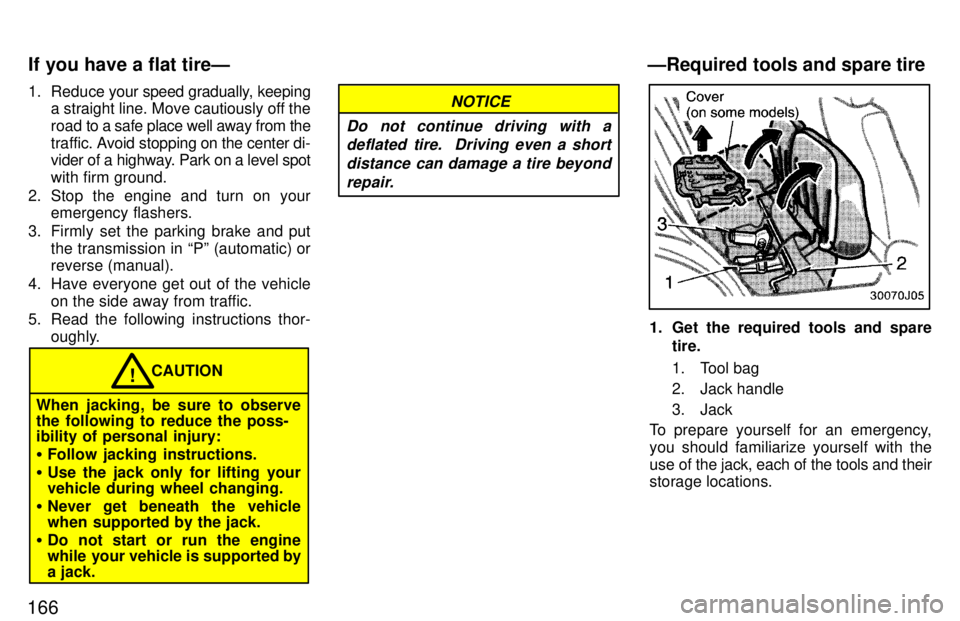
1661. Reduce
your speed gradually, keeping
a straight line. Move cautiously off the
road to a safe place well away from the
traf fic. Avoid stopping on the center di-
vider of a highway. Park on a level spotwith firm ground.
2. Stop the engine and turn on your emergency flashers.
3. Firmly set the parking brake and put the transmission in Pº (automatic) or reverse (manual).
4. Have everyone get out of the vehicle on the side away from traffic.
5. Read the following instructions thor- oughly.
When jacking, be sure to observe
the following to reduce the poss- ibility of personal injury: �Follow jacking instructions.
� Use the jack only for lifting your
vehicle during wheel changing.
� Never get beneath the vehicle
when supported by the jack.
� Do not start or run the engine
while your vehicle is supported bya jack. CAUTION
!
NOTICE
Do not continue driving with a deflated tire. Driving even a short
distance can damage a tire beyondrepair.
1. Get the required tools and spare tire.
1. Tool bag
2. Jack handle
3. Jack
To prepare yourself for an emergency, you should familiarize yourself with the
use of the jack, each of the tools and their storage locations.
If you have a flat tireÐ
ÐRequired tools and spare tire
Page 172 of 223
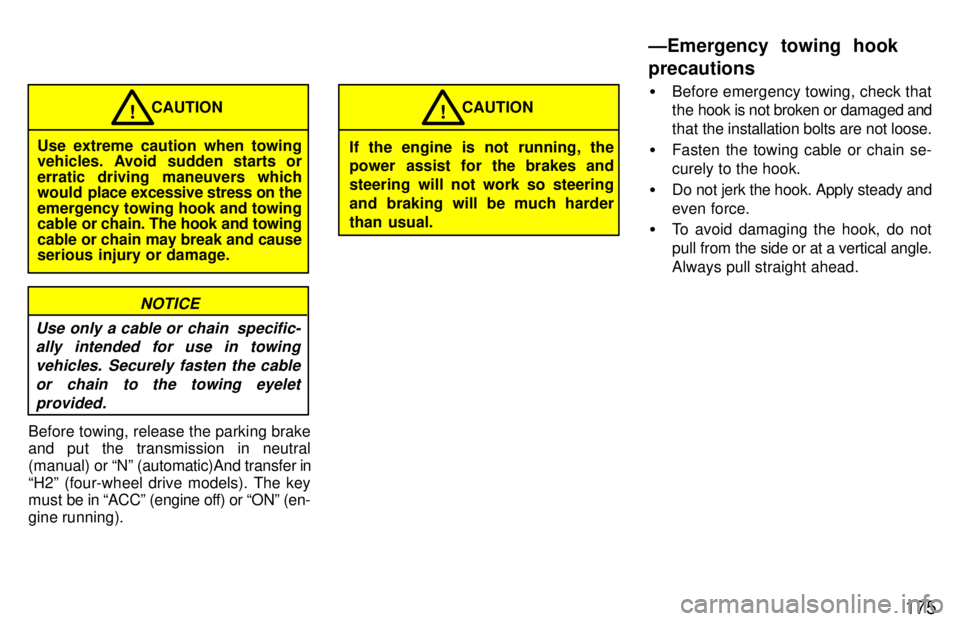
175
CAUTION!
Use extreme caution when towing
vehicles. Avoid sudden starts or
erratic driving maneuvers which
would place excessive stress on the
emergency towing hook and towing
cable or chain. The hook and towing
cable or chain may break and cause
serious injury or damage.
NOTICE
Use only a cable or chain specific- ally intended for use in towing
vehicles. Securely fasten the cableor chain to the towing eyelet provided.
Before towing, release the parking brake
and put the transmission in neutral
(manual) or Nº (automatic)And transfer in
H2º (four-wheel drive models). The key
must be in ACCº (engine off) or ONº (en-
gine running).
CAUTION!
If the engine is not running, the
power assist for the brakes and
steering will not work so steering
and braking will be much harder
than usual. �
Before emergency towing, check that
the hook is not broken or damaged and
that the installation bolts are not loose.
� Fasten the towing cable or chain se-curely to the hook.
� Do not jerk the hook. Apply steady and
even force.
� To avoid damaging the hook, do not
pull from the side or at a vertical angle.
Always pull straight ahead.
ÐEmergency towing hook precautions
Page 174 of 223

177
3. Insert the screwdriver or equivalent
into the hole to push up the shift
lock override button. You can shift
out of Pº position only while push-
ing the button.
4. Shift into Nº position.
5. Insert the cover.
6. Start the engine. For your safety, keep the brake pedal depressed.
Be sure to have the system checked by
your Toyota dealer as soon as possible.If you cannot shift the selector lever
out of Pº position to other positions
even though the brake pedal is de-pressed, use the shift lock override
button as follows:
1. Turn the ignition key to LOCKº position. Make sure the parking brake is set.
2. Pry up the cover with a flat-bladed screwdriver or equivalent.3. Insert your finger into the hole tomove the shift lock override lever
backward. You can shift out of Pº
position only while holding back
the lever.
4. Shift into Nº position.
5. Insert the cover.
6. Start the engine. For your safety, keep the brake pedal depressed.
Be sure to have the system checked by
your Toyota dealer as soon as possible.
If you cannot shift automatic
transmission selector lever
(four-wheel drive models)
Page 183 of 223
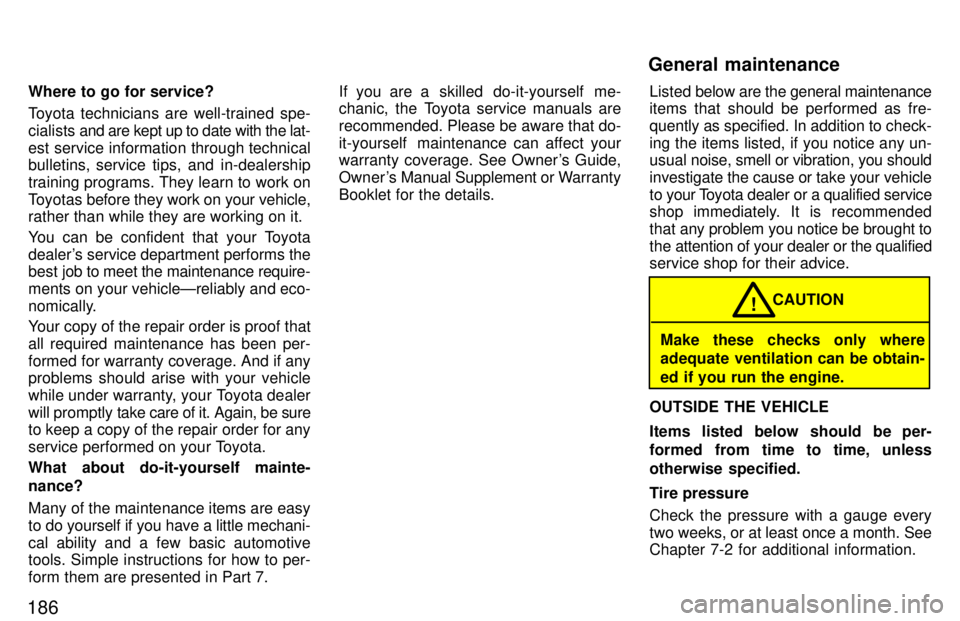
186Where to go for service?
Toyota technicians are well-trained spe- cialists
and are kept up to date with the lat-
est service information through technical
bulletins, service tips, and in-dealership
training programs. They learn to work on
Toyotas before they work on your vehicle,
rather than while they are working on it.
You can be confident that your Toyota
dealer's service department performs the
best job to meet the maintenance require-
ments on your vehicleÐreliably and eco-
nomically.
Your copy of the repair order is proof that
all required maintenance has been per-
formed for warranty coverage. And if any
problems should arise with your vehicle
while under warranty, your Toyota dealer
will promptly take care of it. Again, be sure
to keep a copy of the repair order for any
service performed on your Toyota.
What about do-it-yourself mainte- nance?
Many of the maintenance items are easy
to do yourself if you have a little mechani-
cal ability and a few basic automotive
tools. Simple instructions for how to per-
form them are presented in Part 7. If you are a skilled do-it-yourself me-
chanic, the Toyota service manuals are recommended. Please be aware that do-
it-yourself maintenance can affect your
warranty coverage. See Owner's Guide,
Owner 's
Manual Supplement or W arranty
Booklet for the details. Listed
below are the general maintenance
items that should be performed as fre-quently as specified. In addition to check-
ing the items listed, if you notice any un-
usual noise, smell or vibration, you should
investigate the cause or take your vehicle
to your T oyota dealer or a qualified service
shop immediately. It is recommended
that any problem you notice be brought to
the attention of your dealer or the qualified service shop for their advice.
Make these checks only where
adequate ventilation can be obtain-
ed if you run the engine. CAUTION
!
OUTSIDE THE VEHICLE
Items listed below should be per-
formed from time to time, unless
otherwise specified.
Tire pressure Check the pressure with a gauge every
two weeks, or at least once a month. See Chapter 7-2 for additional information.
General maintenance